+ Open data
Open data
- Basic information
Basic information
| Entry | Database: PDB / ID: 7sl9 | ||||||
|---|---|---|---|---|---|---|---|
| Title | CryoEM structure of SMCT1 | ||||||
 Components Components |
| ||||||
 Keywords Keywords | MEMBRANE PROTEIN / transporter / TRANSPORT PROTEIN-IMMUNE SYSTEM complex | ||||||
| Function / homology |  Function and homology information Function and homology informationacetate transport / propionate transmembrane transporter activity / propanoate transmembrane transport / passive transmembrane transporter activity / monocarboxylate:sodium symporter activity / nicotinate transport / : / lactate transport / organic acid:sodium symporter activity / Organic anion transport by SLC5/17/25 transporters ...acetate transport / propionate transmembrane transporter activity / propanoate transmembrane transport / passive transmembrane transporter activity / monocarboxylate:sodium symporter activity / nicotinate transport / : / lactate transport / organic acid:sodium symporter activity / Organic anion transport by SLC5/17/25 transporters / pyruvate transport / lactate transmembrane transporter activity / nitrate transmembrane transport / monocarboxylic acid transmembrane transporter activity / iodide transport / GINS complex / : / chloride transport / sodium ion transport / monoatomic ion transport / apical plasma membrane / apoptotic process / extracellular exosome / plasma membrane Similarity search - Function | ||||||
| Biological species |  Homo sapiens (human) Homo sapiens (human)synthetic construct (others) | ||||||
| Method | ELECTRON MICROSCOPY / single particle reconstruction / cryo EM / Resolution: 3.5 Å | ||||||
 Authors Authors | Qu, Q. / Han, L. / Panova, O. / Feng, L. / Skiniotis, G. | ||||||
| Funding support | 1items
| ||||||
 Citation Citation |  Journal: Nature / Year: 2022 Journal: Nature / Year: 2022Title: Structure and mechanism of the SGLT family of glucose transporters. Authors: Lei Han / Qianhui Qu / Deniz Aydin / Ouliana Panova / Michael J Robertson / Yan Xu / Ron O Dror / Georgios Skiniotis / Liang Feng /   Abstract: Glucose is a primary energy source in living cells. The discovery in 1960s that a sodium gradient powers the active uptake of glucose in the intestine heralded the concept of a secondary active ...Glucose is a primary energy source in living cells. The discovery in 1960s that a sodium gradient powers the active uptake of glucose in the intestine heralded the concept of a secondary active transporter that can catalyse the movement of a substrate against an electrochemical gradient by harnessing energy from another coupled substrate. Subsequently, coupled Na/glucose transport was found to be mediated by sodium-glucose cotransporters (SGLTs). SGLTs are responsible for active glucose and galactose absorption in the intestine and for glucose reabsorption in the kidney, and are targeted by multiple drugs to treat diabetes. Several members within the SGLT family transport key metabolites other than glucose. Here we report cryo-electron microscopy structures of the prototypic human SGLT1 and a related monocarboxylate transporter SMCT1 from the same family. The structures, together with molecular dynamics simulations and functional studies, define the architecture of SGLTs, uncover the mechanism of substrate binding and selectivity, and shed light on water permeability of SGLT1. These results provide insights into the multifaceted functions of SGLTs. | ||||||
| History |
|
- Structure visualization
Structure visualization
| Movie |
 Movie viewer Movie viewer |
|---|---|
| Structure viewer | Molecule:  Molmil Molmil Jmol/JSmol Jmol/JSmol |
- Downloads & links
Downloads & links
- Download
Download
| PDBx/mmCIF format |  7sl9.cif.gz 7sl9.cif.gz | 113.5 KB | Display |  PDBx/mmCIF format PDBx/mmCIF format |
|---|---|---|---|---|
| PDB format |  pdb7sl9.ent.gz pdb7sl9.ent.gz | 90.2 KB | Display |  PDB format PDB format |
| PDBx/mmJSON format |  7sl9.json.gz 7sl9.json.gz | Tree view |  PDBx/mmJSON format PDBx/mmJSON format | |
| Others |  Other downloads Other downloads |
-Validation report
| Summary document |  7sl9_validation.pdf.gz 7sl9_validation.pdf.gz | 724.6 KB | Display |  wwPDB validaton report wwPDB validaton report |
|---|---|---|---|---|
| Full document |  7sl9_full_validation.pdf.gz 7sl9_full_validation.pdf.gz | 726.9 KB | Display | |
| Data in XML |  7sl9_validation.xml.gz 7sl9_validation.xml.gz | 22.4 KB | Display | |
| Data in CIF |  7sl9_validation.cif.gz 7sl9_validation.cif.gz | 32.4 KB | Display | |
| Arichive directory |  https://data.pdbj.org/pub/pdb/validation_reports/sl/7sl9 https://data.pdbj.org/pub/pdb/validation_reports/sl/7sl9 ftp://data.pdbj.org/pub/pdb/validation_reports/sl/7sl9 ftp://data.pdbj.org/pub/pdb/validation_reports/sl/7sl9 | HTTPS FTP |
-Related structure data
| Related structure data |  25195MC  7sl8C  7slaC M: map data used to model this data C: citing same article ( |
|---|---|
| Similar structure data |
- Links
Links
- Assembly
Assembly
| Deposited unit | 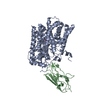
|
|---|---|
| 1 |
|
- Components
Components
| #1: Protein | Mass: 67636.219 Da / Num. of mol.: 1 Source method: isolated from a genetically manipulated source Source: (gene. exp.)  Homo sapiens (human) / Gene: SLC5A8, AIT, SMCT, SMCT1 / Production host: Homo sapiens (human) / Gene: SLC5A8, AIT, SMCT, SMCT1 / Production host:  Homo sapiens (human) / References: UniProt: Q8N695 Homo sapiens (human) / References: UniProt: Q8N695 |
|---|---|
| #2: Antibody | Mass: 14441.961 Da / Num. of mol.: 1 Source method: isolated from a genetically manipulated source Source: (gene. exp.) synthetic construct (others) / Production host:  |
| #3: Chemical | ChemComp-BUA / |
| Has ligand of interest | Y |
-Experimental details
-Experiment
| Experiment | Method: ELECTRON MICROSCOPY |
|---|---|
| EM experiment | Aggregation state: PARTICLE / 3D reconstruction method: single particle reconstruction |
- Sample preparation
Sample preparation
| Component | Name: SMCT1 and nanobody complex / Type: COMPLEX / Entity ID: #1-#2 / Source: MULTIPLE SOURCES |
|---|---|
| Source (natural) | Organism:  Homo sapiens (human) Homo sapiens (human) |
| Source (recombinant) | Organism:  Homo sapiens (human) Homo sapiens (human) |
| Buffer solution | pH: 7 |
| Specimen | Embedding applied: NO / Shadowing applied: NO / Staining applied: NO / Vitrification applied: YES |
| Vitrification | Cryogen name: ETHANE |
- Electron microscopy imaging
Electron microscopy imaging
| Experimental equipment |  Model: Titan Krios / Image courtesy: FEI Company |
|---|---|
| Microscopy | Model: FEI TITAN KRIOS |
| Electron gun | Electron source:  FIELD EMISSION GUN / Accelerating voltage: 300 kV / Illumination mode: FLOOD BEAM FIELD EMISSION GUN / Accelerating voltage: 300 kV / Illumination mode: FLOOD BEAM |
| Electron lens | Mode: BRIGHT FIELD |
| Image recording | Electron dose: 56 e/Å2 / Detector mode: COUNTING / Film or detector model: GATAN K2 SUMMIT (4k x 4k) |
- Processing
Processing
| CTF correction | Type: NONE |
|---|---|
| 3D reconstruction | Resolution: 3.5 Å / Resolution method: FSC 0.143 CUT-OFF / Num. of particles: 173859 / Symmetry type: POINT |
 Movie
Movie Controller
Controller





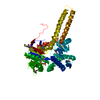

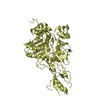
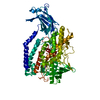
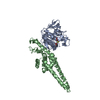
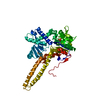
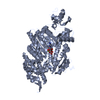
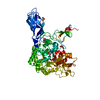
 PDBj
PDBj



